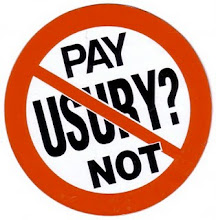About The Creation Of Money

By Tom J. Kennedy
Ask any person how money is generally created and s/he is likely to tell you that the banks or the mint does it somehow. Ask any person specifically where the money for their personal loan or mortgage comes from and s/he is likely to say that it comes from depositors' funds.
Nothing could be further from the truth. It is the signature of the debtor on the promissory note that authorizes the bank to create the principal out of thin air and hypothetize your asset. Such money is created by debt. Banks dont lend money. The money is really created by the borrower who signs the promissory note. Almost all money is created by debt, so if there was no debt there would be no money. The primary way to expand the money supply is to create war.
Furthermore, the bank does not create the interest or usury but it exacts such along with the principal from the debtor. Through a process of constructive forgery where neither the debtor (borrower) nor the banker (creditor) bring anything to the table a loan is created whereby you sign an IOU to the bank and the bank treats the IOU as money. You have created new money by a pledge of debt.
During the 20th Century the fractional reserve system permitted banks to create and loan $9000.00 when a depositor deposited $1000.00. Fractional reserve banking means that commercial banks were required to keep a specified reserve to qualify them to create and lend mortgages or loans to debtors legally. Governments took away the fractional reserve requirements for most commercial banks during the latter years of the 20th Century.
Government relies on taxes and/or borrowing as their prime methods of financing. Any government commonly raises funds through the borrowing method by selling its bonds on the open market operations. These government bonds are bought by the large transnational corporations, insurance companies and/or commercial banks.
By this government borrowing method to raise funds the taxpayers pay the principal for the infrastructure of highways, bridges or whatever plus the interest or usury costs. Most government funding of this modern era is by this borrowing method and the taxpayer pays the interest or usury to the banks and large corporations for just about everything the government offers, with most taxes giving directly for debt service on the government debt.
In summary, the funds of the wage earners are transferred through taxes to the wealthy holders of capital. Even more noteworthy, is the fact that the community must pay more back than it originally received, which of course is an impossibility. There is a withdrawal of currency when debtors pay back their loans.
The alternative to this conventional system of money creation through reliance on debt is the action of the government directly investing into the production of consumer goods. The Parliament of Canada has the authority to create and spend the money directly into the economy without an interest or usury cost.
In the early 1800's, the small island of Guernsey off the coast of Normandy, France implemented a system of money creation where a direct expenditure was used. The island of Guernsey was impoverished and the population was in decline. The local town council simply issued Guernsey Island paper notes instead of seeking usury-based loans from banks. This resulted in a dramatic improvement in the islands standard of living.
Money was issued on road construction and public market and neither inflation nor public debt occurred as the notes were removed by taxes.
As we progress into this 21st century, it is imperative that municipal governments study the Guernsey model with a goal to implement such a creative strategy to solve the ever-present shortage of money. The usuryfree community currency movement is likewise positioned to offer resources and expertise on how any municipality can create and spend its own usuryfree community currency.
Note: Readers are invited to read "The Innovative Proposal" at this url:
http://usuryfree.blogspot.com/2010/04/innovative-proposal.html


0 Comments:
Post a Comment
<< Home